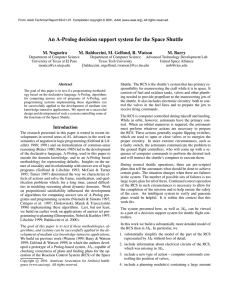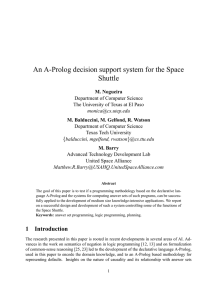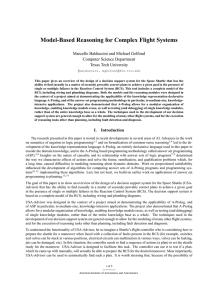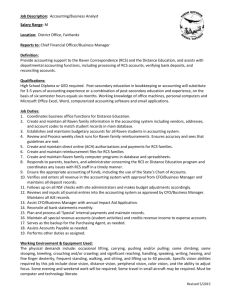An A-Prolog decision support system for the Space Shuttle M. Nogueira
advertisement
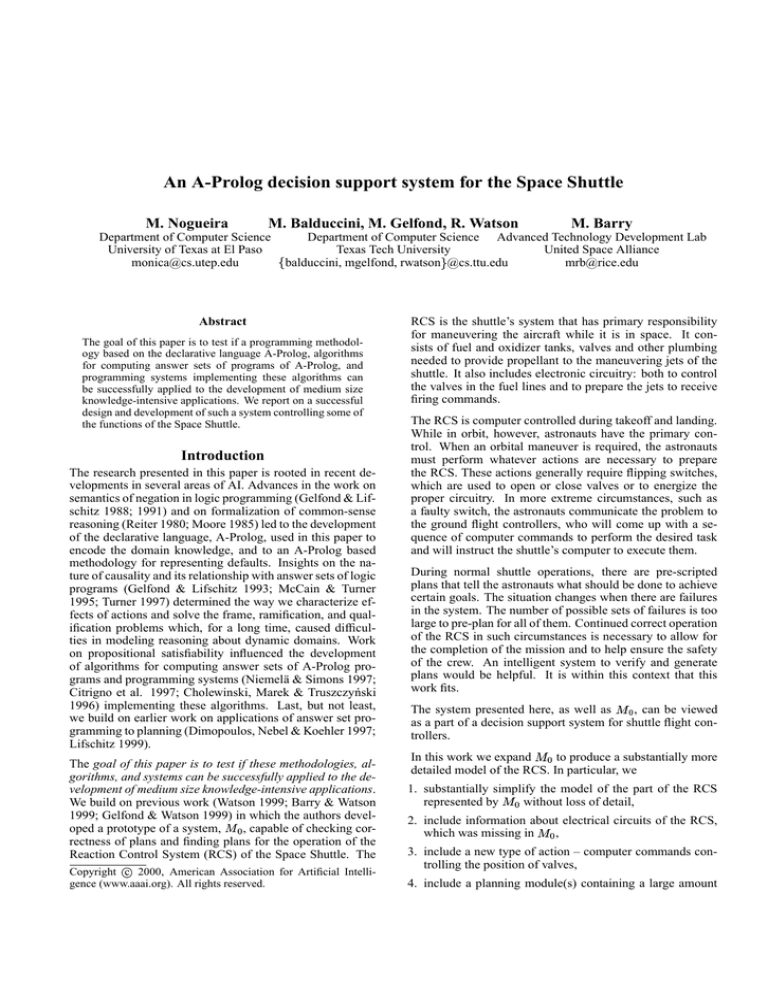
An A-Prolog decision support system for the Space Shuttle
M. Nogueira
M. Balduccini, M. Gelfond, R. Watson
Department of Computer Science
University of Texas at El Paso
monica@cs.utep.edu
Abstract
The goal of this paper is to test if a programming methodology based on the declarative language A-Prolog, algorithms
for computing answer sets of programs of A-Prolog, and
programming systems implementing these algorithms can
be successfully applied to the development of medium size
knowledge-intensive applications. We report on a successful
design and development of such a system controlling some of
the functions of the Space Shuttle.
Introduction
The research presented in this paper is rooted in recent developments in several areas of AI. Advances in the work on
semantics of negation in logic programming (Gelfond & Lifschitz 1988; 1991) and on formalization of common-sense
reasoning (Reiter 1980; Moore 1985) led to the development
of the declarative language, A-Prolog, used in this paper to
encode the domain knowledge, and to an A-Prolog based
methodology for representing defaults. Insights on the nature of causality and its relationship with answer sets of logic
programs (Gelfond & Lifschitz 1993; McCain & Turner
1995; Turner 1997) determined the way we characterize effects of actions and solve the frame, ramification, and qualification problems which, for a long time, caused difficulties in modeling reasoning about dynamic domains. Work
on propositional satisfiability influenced the development
of algorithms for computing answer sets of A-Prolog programs and programming systems (Niemelä & Simons 1997;
Citrigno et al. 1997; Cholewinski, Marek & Truszczyński
1996) implementing these algorithms. Last, but not least,
we build on earlier work on applications of answer set programming to planning (Dimopoulos, Nebel & Koehler 1997;
Lifschitz 1999).
The goal of this paper is to test if these methodologies, algorithms, and systems can be successfully applied to the development of medium size knowledge-intensive applications.
We build on previous work (Watson 1999; Barry & Watson
1999; Gelfond & Watson 1999) in which the authors developed a prototype of a system,
, capable of checking correctness of plans and finding plans for the operation of the
Reaction Control System (RCS) of the Space Shuttle. The
Copyright c
M. Barry
Department of Computer Science Advanced Technology Development Lab
United Space Alliance
Texas Tech University
balduccini, mgelfond, rwatson @cs.ttu.edu
mrb@rice.edu
2000, American Association for Artificial Intelligence (www.aaai.org). All rights reserved.
RCS is the shuttle’s system that has primary responsibility
for maneuvering the aircraft while it is in space. It consists of fuel and oxidizer tanks, valves and other plumbing
needed to provide propellant to the maneuvering jets of the
shuttle. It also includes electronic circuitry: both to control
the valves in the fuel lines and to prepare the jets to receive
firing commands.
The RCS is computer controlled during takeoff and landing.
While in orbit, however, astronauts have the primary control. When an orbital maneuver is required, the astronauts
must perform whatever actions are necessary to prepare
the RCS. These actions generally require flipping switches,
which are used to open or close valves or to energize the
proper circuitry. In more extreme circumstances, such as
a faulty switch, the astronauts communicate the problem to
the ground flight controllers, who will come up with a sequence of computer commands to perform the desired task
and will instruct the shuttle’s computer to execute them.
During normal shuttle operations, there are pre-scripted
plans that tell the astronauts what should be done to achieve
certain goals. The situation changes when there are failures
in the system. The number of possible sets of failures is too
large to pre-plan for all of them. Continued correct operation
of the RCS in such circumstances is necessary to allow for
the completion of the mission and to help ensure the safety
of the crew. An intelligent system to verify and generate
plans would be helpful. It is within this context that this
work fits.
The system presented here, as well as
, can be viewed
as a part of a decision support system for shuttle flight controllers.
In this work we expand
to produce a substantially more
detailed model of the RCS. In particular, we
1. substantially simplify the model of the part of the RCS
represented by
without loss of detail,
2. include information about electrical circuits of the RCS,
which was missing in
,
3. include a new type of action – computer commands controlling the position of valves,
4. include a planning module(s) containing a large amount
of heuristic information (this substantially improves quality of the plans and efficiency of the search),
5. include a Java interface to simplify the use of the system
by a flight controller and by the system designers.
The resulting system, , seems to be suitable for practical
applications. The work on its deployment at United Space
Alliance is scheduled to start in December of the year 2000.
To understand the functionality of let us imagine a shuttle
controller who is considering how to prepare the shuttle for
a maneuver when faced with a collection of faults present in
the RCS (for example, switches and valves can be stuck in
various positions, electrical circuits can malfunction in various ways, valves can be leaking, jets can be damaged, etc).
In this situation, the controller needs to find a sequence of
actions (a plan) to ready the shuttle for the maneuver.
can serve as a tool facilitating this task. The controller can
use it to test if a plan, which he came up with manually, will
actually be able to prepare the RCS for the desired maneuver. The system can also be used to automatically find such
a plan. In the next section we will give a brief introduction
into the design of the system.
System’s Design
The system, , consists of a collection of largely independent modules, represented by lp-functions 1 and a graphical
Java interface, . The interface gives a simple means for the
user to enter information about the history of the RCS, its
faults, and the task to be performed. At the moment there
are two possible types of tasks: checking if a sequence of
occurrences of actions in the history of the system satisfies a
goal, , and finding a plan for of a length not exceeding
some number of steps, . Based on this information, verifies the input is complete, selects an appropriate combination of modules, assembles them into an A-Prolog program,
, and passes as an input to a reasoning system for comthis role is currently played by
puting stable models (In
SMODELS , however we also plan to investigate performance
of other systems.) In this approach the task of checking a
plan is reduced to checking if there exists a model of the
program
. A planning module is used to describe a
set of possible plans the user is interested in and the correctness theorem guarantees that there is a one-to-one correspondence between the plans and the set of stable models
of the program. Planning is reduced to finding such models.
Finally, the Java interface extracts the appropriate answer
from the SMODELS output and displays it in a user-friendly
format.
In the rest of this section we give a slightly more detailed
description of particular modules.
1
By an lp-function we mean program of A-Prolog with input
and
and a set
of sets
and output signatures
such that, for any
,
is
of literals from
consistent, i.e. has an answer set.
Plumbing module
The Plumbing Module (
) models the plumbing system
of the RCS, which consists of a collection of tanks, jets
and pipe junctions connected through pipes. The flow of
fluids through the pipes is controlled by valves. The system’s purpose is to deliver fuel and oxidizer from tanks to
the jets needed to perform a maneuver. The structure of
,
the plumbing system is described by a directed graph,
whose nodes are tanks, jets and pipe junctions, and whose
arcs are labeled by valves. The possible faults of the system
at this level are leaky valves, damaged jets, and valves stuck
in some position.
!
"
The rules of
define a function which takes as input the
structural description,
, of the plumbing system, its state
including position of valves and the list of faulty components, and determines: the distribution of pressure through
the nodes of
; which jets are ready to fire; which maneuvers are ready to be performed.
"
# %$&'&)(*+- ,.$ / 0214357698;:<
8;:
To illustrate the issues involved in the construction of
, let us consider the definition of fluent
, describing the pressure on a node
by a tank
. It is not difficult to define this relation for
the tank nodes. For other nodes, the definition is recursive.
It says that any non-tank node
is pressurized by a tank
if
is not leaking and is connected by an open valve
to a node
which is pressurized by
.
8;: >=
@?
>=
8;:
Representation of this definition in standard Prolog is problematic, since the corresponding graph can contain cycles.
(This fact is partially responsible for the relative complexity
of this module in
.) The ability of A-Prolog to express
and to reason with recursion allows us to use the following
concise definition of pressure on non-tank nodes.
h(pressurized_by(N1,Tk),T) :not tank_of(N1,R),
not h(leaking(N1),T),
link(N2,N1,V),
h(in_state(V,open),T),
h(pressurized_by(N2,Tk),T).
The Plumbing Module consists of approximately 40 rules.
Valve control module
The flow of fuel and oxidizer propellants from tanks to
jets is controlled by opening/closing valves along the path.
The state of valves can be changed either by manipulating mechanical switches or by issuing computer commands.
Switches and computer commands are connected to the
valves, they control, by electrical circuits.
ACB
A
ACB
The action of flipping a switch
to some position normally puts a valve controlled by
in this position. Similarly for computer commands. There are, however, three
types of possible failures: switches and valves can be stuck
in some position, and electrical circuits can malfunction in
various ways. Substantial simplification of the
module is achieved by dividing it in two parts, called basic and
extended
modules.
DFE DFE At the basic level, it is assumed that all electrical circuits are
working properly and therefore are not included in the representation. The extended level includes information about
electrical circuits and is normally used when some of the
circuits are malfunctioning. In that case, flipping switches
and issuing computer commands may produce results that
cannot be predicted by the basic representation.
DFE Basic valve control module At this level, the
deals
with a set of switches, computer commands and valves, and
connections among them. The input of the basic
consists of the initial positions and faults of switches and
valves, and the sequence of actions defining the history of
events. The module implements an lp-function that, given
this input, returns positions of valves at the current moment
of time. This output is used as input to the plumbing module. The possible faults of the system at this level are valves
and switches stuck at some position(s).
DE
DFE Effects of actions in the basic
are described in a variant of action language , which contains both static and dynamic causal laws, as well as impossibility conditions. Our
version of uses a slightly different syntax to avoid lists and
nesting of function symbols, because of limitations of the inference engines currently available. The use of allows to
prove correctness of logic programming implementation of
causal laws (Gelfond & Gabaldon 1997). (Of course, it does
not guarantee correctness of the causal laws per se. This
can only be done by domain experts.) The complexity of
this representation makes it hard to employ STRIPS-like formalisms.
The following rules show an example of syntax and use of
our version of . The first is a dynamic causal rule stating
that, if a properly working switch
is flipped to state at
time , then
will be in this state at the next moment of
time.
8
ACB
ACB
A
h(in_state(Sw,S),T+1) :occurs(flip(Sw,S),T),
not stuck(Sw).
A static connection between switches and valves is expressed by the next rule. This static law says that, under
controlling a valve is in
normal conditions, if switch
some state (different from gpc2 ) at time , then is also
in this state at the same time.
A
ACB
8
D
D
h(in_state(V,S),T) :controls(Sw,V),
h(in_state(Sw,S),T),
neq(S,gpc),
not h(ab_input(V),T),
not stuck(V),
not bad_circuitry(V).
AB
A=
A= A ?
0 + # (3 D
<
A?
DE
DE
Extended valve control module The extended
encompasses the basic
and also includes information
about electrical circuits, power and control buses, and the
wiring connections among all the components of the system.
DE
This module, too, defines an lp-function. It takes as input
the same information accepted by the basic
, together
with faults on power buses, control buses and electrical circuits. The extended
returns positions of valves at the
.
current moment of time, exactly like the basic
DFE DE
Since (possibly malfunctioning) electrical circuits are part
of the representation, it is necessary to compute the signals present on all wiring connections, in order to determine the positions of valves. The signals present on the
circuit’s wires are generated by the Circuit Theory Module
(CTM), included in the extended
. Since this module was developed independently to address a different collection of tasks (Balduccini, Gelfond & Nogueira 2000a;
2000b), its use in this system is described in a separate section.
DFE D E
The state of a valve in the extended
is determined by
the signals present on its two input wires, labeled open and
closed. If the open wire is set to 1 and the closed wire is set
to 0, the valve moves to state open. Similarly for the state
closed. The following static law defines this behavior.
h(in_state(V,S1),T) :input(W1,V),
input(W2,V),
input_of_type(W1,S1),
input_of_type(W2,S2),
h(value(W1,1),T),
h(value(W2,0),T),
neq(S1,S2),
not stuck(V).
The output signals of switches, valves, power buses and control buses are also defined by means of static causal laws.
D
The condition not bad circuitry(V) is used to stop this rule
from being applied when the circuit connecting
and is
not working properly. (Notice that the above dynamic rule
2
is applied independently of the functioning conditions of the
circuit, since it is related only to the switch itself.) If the
switch is in a position,
, different from gpc, and a computer command is issued to move the valve to position ,
. This is an abnormal
then there is a conflict in case
situation, which is expressed by fluent
. When
this fluent is true, negation as failure is used to stop the application of this rule. In fact, the final position of the valve
can only be determined by using the representation of the
electrical circuit that controls it. This will be discussed in
the next section.
A switch can be in one of three positions: open, closed, or gpc.
When it is in gpc, it does not affect the state of the valve.
At this level, the representation of a switch is extended by
a collection of input and output wires. Each input wire is
associated to one and only one output wire, and every input/output pair is linked to a position of the switch. When
a switch is in position , an electrical connection is established between input
and output
of the pair(s) corresponding to . Therefore the signal present on
is transferred to
, as expressed by the following rule.
A
A
+
+
h(value(Wo,X),T) :h(in_state(Sw,S),T),
connects(S,Sw,Wi,Wo),
h(value(Wi,X),T).
DE
In this module, few rules are required. The
the Circuit Theory module, consists of 36 rules.
Circuit theory module
neq(W1,W2),
h(value(W1,X),T),
h(value(W2,1),T),
output(W,G),
not is_stuck(W,G).
, without
E!8 The Circuit Theory Module (
) is a general description of components of electrical circuits. It can be used as
a stand-alone application for simulation, computation of the
topological delay of a circuit, detection of glitches, and abduction of the circuit’s inputs given the desired output.
E!8 The
is employed in this system to model the electrical circuits of the RCS, which are formed by digital gates
and other electrical components, connected by wires. Here,
we refer to both types of components as gates. The structure
of an electrical circuit is represented by a directed graph
where gates are nodes and wires are arcs. A gate can possibly have a propagation delay associated with it, where
is a natural number (zero indicates no delay). All signals
present in the circuit are expressed in 3-valued logic (0, 1,
u). If no value is present on a wire at a certain moment of
time then it is said to be unknown (u) at .
8
8
This module describes the normal and faulty behavior of
electrical circuits with possible propagation delays and 3valued logic.
E!8 In
, input wires of a circuit are defined as the wires
coming from switches, valves, computer commands, power
buses and control buses. Output wires are those that go to
valves. The
is an lp-function that takes as input the
description of a circuit , the values of signals present on
its input wires, the set of faults affecting its gates, and determines the values on the output wires of at the current
moment of time.
E"8 E
E
We allow for standard faults from the theory of digital circuits. A gate malfunctions if its output, or at least one of
its input pins, are permanently stuck on a signal value. The
effect of a fault associated to a gate of the direct graph
only propagates forward.
E!8 contains two sets of static rules. One of them allows
for the representation of the normal behavior of gates, while
the other expresses their faulty behavior. To illustrate how
the normal behavior of gates is described in the
, let us
consider the case of the Tri-State gate. This type of component has two input wires, of which one is labeled enable. If
this wire is set to 1, the value of the other input is transferred
to the output wire. Otherwise, the output is undefined. The
following rule describes the normal behavior of the Tri-State
gate when it is enabled.
E"8 h(value(W,X),T+D) :delay(G,D),
input(W1,G),
input(W2,G),
type_of_wire(W2,G,enable),
It is interesting to discuss how faults are treated when they
occur on the input wire of a gate. Let us consider the
with an input wire stuck at value .
case of a gate
and
This wire is represented as two unconnected wires,
, corresponding to the normal and faulty
sections of the wire. The faulty part is stuck at value ,
while the value of
is computed by normal rules depending upon its connection to the output of other gates. Rules
for gates with faulty inputs use as input
wire. The example below is related to a Tri-State gate with
the non-enable wire stuck to .
& -( ): B + %$.3 <
& -( : B + %$.3 <
h(value(W,X),T+D) :delay(G,D),
input(stuck_wire(W1),G),
input(W2,G),
type_of_wire(W2,G,enable),
neq(W1,W2),
h(value(stuck_wire(W1),X),T),
h(value(W2,1),T),
output(W,G),
not is_stuck(W,G).
Notice that condition not is stuck(W,G) prevents the above
rules from being applied when the output wire is stuck.
Whenever an output wire is stuck at , the corresponding
rule guarantees that its signal value is always .
The behavior of a circuit is said normal if all its gates are
functioning correctly. If one or more gates of a circuit malfunction then the circuit is called faulty.
The description of faulty electrical circuit(s) is included as
part of the RCS representation. However, it is not necessary to add the description of normal circuits controlling a
valve(s) since the program can reason about effects of actions performed on that valve through the basic
. This
allows for an increase in efficiency when computing models
of the program.
DE
The Circuit Theory module contains approximately 50 rules.
Planning module
This module establishes the search criteria used by the program to find a plan, i.e. a sequence of actions that, if executed, would achieve the goal. The modular design of
allows for the creation of a variety of such modules.
The structure of the Planning Module (
) follows the
generate and test approach of (Dimopoulos, Nebel &
Koehler 1997; Lifschitz 1999). Since the RCS contains
more than 200 actions, with rather complex effects, and may
require very long plans, this standard approach needs to be
substantially improved. This is done by addition of various
forms of heuristic, domain-dependent, information. In particular, the generation part takes advantage of the fact that
the RCS consists of three, largely independent, subsystems.
A plan for the RCS can therefore be viewed as the composition of three separate plans that can operate in parallel.
Generation is implemented using the following rule:
1{occurs(A,T): action_of(A,R)}1 :subsystem(R),
not goal(T,R).
This rule states that exactly one action for each subsystem
of the RCS should occur at each moment of time, until the
goal is reached for that subsystem. Notice that the head of
this rule has the form
defines a subset
of terms such that . .It Normally,
there
are many possible sets satisfying these conditions. Hence,
a program containing this type of rules has multiple answer
sets, corresponding to possible choices of .
# 3 < 3 < #
#
#
In the RCS, the common task is to prepare the shuttle for a
given maneuver. The goal of preparing for such a maneuver can be split into several subgoals, each setting some jets,
from a particular subsystem, ready to fire. The overall goal
can therefore be stated as a composition of the goals of individual subsystems containing the desired jets, as follows:
the time required to find a plan for tasks involving a large
number of faults was reduced from hours to seconds.
Figure 1 presents a summary of five experiments. The
columns of the table indicate: task name; number of RCSs
subsystems involved in the task; number of steps required to
reach the goal; total number of actions required to achieve
the goal (actions of different subsystems may be executed in
parallel); number of faults affecting the RCS; time needed
to check a plan; time needed to find a plan. All times are expressed in seconds and were taken on a Pentium II 350MHz
system, running NetBSD 1.4.1, LPARSE 0.99.59 and SMOD ELS 2.26.
Task
ex1
ex2
ex3
ex4
ex5
RCSs
1
2
2
3
2
steps
5
3
4
8
4
actions
5
6
8
20
4
faults
2
0
2
10
2
check
1.01
0.66
0.82
1.57
0.83
plan
4.74
2.14
5.9
98.74
2.61
Figure 1: Results of plan checking and planning on sample
tasks without malfunctioning circuits.
goal :goal(T1,left_rcs),
goal(T2,right_rcs),
goal(T3,fwd_rcs).
The plan testing phase of the search is implemented by the
following constraint
:- not goal.
which eliminates the models that do not contain plans for the
goal.
Splitting into subsystems allows us to improve the efficiency
of the module substantially. For instance, finding a plan of 5
steps takes 4.74 seconds, as opposed to some hours required
when the representation of the RCS is not partitioned in subsystems. Notice that, since there are some dependencies between some subsystems, a very small number of extremely
rare (and undesirable) plans can be missed. It’s possible to
modify the Planning module in order to find these plans, but
this issue was not investigated in this paper.
The module contains also other domain-dependent as well as
domain-independent heuristics. The reasons for adding such
heuristics are two-fold: first, to eliminate plans which are
correct but unintended, and second, to increase efficiency.
A-Prolog allows for a concise representation of these heuristics as constraint rules. Domain-independent heuristics express common-sense knowledge like “under normal conditions, do not perform two different actions with the same
effect.” Domain-dependent rules embody common-sense
knowledge of the type “do not pressurize nodes which are
already pressurized.”
Our experiments show that some of the domain-dependent
heuristics play a crucial role on the efficiency of the planning
module. The impact of such heuristics was made clear when
Conclusion
In this paper we described a medium size decision support
system written in A-Prolog. This application requires modeling of the operation of a fairly complex subsystem of the
Space Shuttle at a level suitable for use by shuttle flight controllers. It is expected that deployment of this system, for
use in the space program, will begin in December of 2000.
The system, while based on previous work, represents a substantial advance over its predecessor.
From the scientific standpoint, this work can be of interest
to two groups of people, those interested in answer set programming and those interested in planning. We hope both
groups will be glad to learn about the existence of a comparatively big and practical software system written in AProlog. The former group can also learn about advantages
of A-Prolog with respect to standard Prolog, evident even in
the case of plan checking.
An important methodological lesson we learned from this
exercise is the importance of careful initial design. For instance, introduction of junction nodes in the model of the
Plumbing Module of the RCS substantially simplified the
resulting program. We are also satisfied with our use of the
Java interface for selecting modules necessary for solving a
given problem, and integrating these modules into a final AProlog program. Structuring most modules as lp-functions
contributed to the reusability and proof of correctness of the
integration3 . Such proof is especially important due to the
critical nature of the RCS.
3
To give an example of what we learned here, let us consider
the following situation: suppose you have lp-functions and correctly implementing the plumbing and basic modules of the
system; integration of these modules leads to the creation of new
The people from planning may find it interesting to see a system of substantial size built on theory of actions and change.
In particular, we were somewhat surprised by the importance of static causal laws in our model. We are not sure
that the use of STRIPS-like languages containing only dynamic causal laws is sufficient for a concise representation
.
of the RCS, and especially of the extended
DE
The use of A-Prolog allowed us to deal with recursive causal
laws, which may pose a problem to more classical planning methods. Recent work in planning drew attention to
the problem of finding a language which would allow a
declarative and efficient representation of heuristic information (Bacchus & Kabanza 1998; Kautz & Selman 1998;
Huang, Kautz & Selman 1999; Finzi, Pirri & Reiter 2000).
We believe that this paper demonstrates that a large amount
of such information can be naturally expressed in A-Prolog.
Moreover, its use dramatically improves efficiency of the
planner (which is not always the case for satisfiability based
planners.) Finally, it may be interesting to see how modularity allows planning to be performed in different levels. It is
easy, for instance, to modify our planning module to search
for manual plans, i.e., those not including computer commands. The new planner will be much more efficient and, in
many cases, sufficient for the flight controllers’ needs. We
have plans of applying these techniques to modeling other
systems of the shuttle.
Acknowledgments
This work was partially supported by a research grant from
United Space Alliance.
References
F. Bacchus and F. Kabanza. 1998. Planning for Temporally
Extended Goals. Annals of Mathematics and Artificial Intelligence, 22:1-2, 5-27.
M. Balduccini, M. Gelfond and M. Nogueira. 2000a. AProlog as a tool for declarative programming. Proc. of the
12th International Conference on Software Engineering
and Knowledge Engineering (SEKE’2000).
M. Balduccini, M. Gelfond and M. Nogueira. 2000b. Digital Circuits in -Prolog. Technical Report, University of
Texas at El Paso.
M. Barry and R. Watson. 1999. Reasoning about actions
for spacecraft redundancy management. Procs of the 1999
IEEE Aerospace Conference, 5:101–112.
P. Cholewinski, W. Marek and M. Truszczyński. 1996.
Default Reasoning System DeReS. In Int’l Conf. on Principles of Knowledge Representation and Reasoning, 518528. Morgan Kauffman.
. It is known that, due to non-monotonicity of
lp-function
A-Prolog, logic programming representation of this function cannot always be obtained by combining together rules of and . In
our case, however, a general theorem (Gelfond & Gabaldon 1997)
can be used to check if this is indeed the case. We are currently
working on formulating and proving the correctness of the complete integration.
S. Citrigno, T. Eiter, W. Faber, G. Gottlob, C. Koch, N.
Leone, C. Mateis., G. Pfeifer and F. Scarcello. 1997. The
dlv system: Model generator and application frontends.
Procs of the 12th Workshop on Logic Programming, 128–
137.
Y. Dimopoulos, B. Nebel, and J. Koehler. 1997. Encoding
planning problems in nonmonotonic logic programs. Lecture Notes in Artificial Intelligence - Recent Advances in AI
Planning, Procs of the 4th European Conference on Planning, ECP’97, 1348:169–181.
M. Gelfond and A. Gabaldon. 1997. From Functional
Specifications to Logic Programs. Procs. of ILPS’97.
M. Gelfond and V. Lifschitz. 1988. The Stable Model Semantics for Logic Programs. In Proc. of the 5th Int’l Conf.
on Logic Programming, 1070-1080.
M. Gelfond and V. Lifschitz. 1993. Representing Actions and Change by Logic Programs. Journal of Logic
Programming, 17:301–323.
M. Gelfond and V. Lifschitz. 1991. Classical Negation in
Logic Programs and Disjunctive Databases. New Generation Computing, 9(3/4):365-386.
M. Gelfond, and R. Watson. 1999. On methodology for
representing knowledge in dynamic domains. Proc. of the
1998 ARO/ONR/NSF/DARPA Monterey Workshop on Engineering Automation for Computer Based Systems, 57–66.
H. Kautz and B. Selman. 1998. The Role of DomainSpecific Knowledge in the Planning as Satisfiability
Framework. Proc. AIPS-98.
Y. Huang, H. Kautz and B. Selman. 1999. Control Knowledge in Planning: Benefits and Tradeoffs. 16th National
Conference of Artificial Intelligence (AAAI’99), 511–517.
V. Lifschitz. 1999. Action languages, Answer Sets, and
Planning. In The Logic Programming Paradigm: a 25-Year
Perspective. Spring-Verlag.
N. McCain and H. Turner. 1995. A causal theory of ramifications and qualifications. Proc. of IJCAI 95, 1978-1984.
R. Moore. 1985. Semantical considerations on nonmonotonic logic. Artificial Intelligence, 25(1):75-94.
I. Niemelä, and P. Simons. 1997. Smodels - an implementation of the stable model and well-founded semantics for
normal logic programs. Procs of the 4th International Conference on Logic Programming and Non-Monotonic Reasoning, 420–429.
A. Finzi, F. Pirri and R. Reiter. 2000. Open World Planning in the Situation Calculus. 17th National Conference
of Artificial Intelligence (AAAI’00), 754–760.
R. Reiter. 1980. A logic for default reasoning. Artificial
Intelligence, 13(1,2):81-132.
H. Turner. 1997. Representing actions in logic programs
and default theories: A situation calculus approach. Journal of Logic Programming, Vol. 31, No. 1-3, 245-298.
R. Watson. 1999. An application of action theory to
the space shuttle. Lecture Notes in Computer Science Procs of Practical Aspects of Declarative Languages ’99,
1551:290–304.


